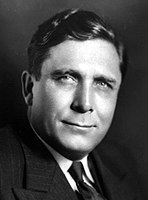1940 United States presidential election in Massachusetts
This article relies largely or entirely on a single source. (August 2013) |
| ||||||||||||||||||||||||||
| Turnout | 78.7%[1] | |||||||||||||||||||||||||
|---|---|---|---|---|---|---|---|---|---|---|---|---|---|---|---|---|---|---|---|---|---|---|---|---|---|---|
| ||||||||||||||||||||||||||
| ||||||||||||||||||||||||||
| ||||||||||||||||||||||||||
| Elections in Massachusetts |
|---|
 |
|
|
The 1940 United States presidential election in Massachusetts took place on November 5, 1940, as part of the 1940 United States presidential election, held throughout all contemporary 48 states. Voters chose 17 representatives, or electors to the Electoral College, who voted for president and vice president.
Massachusetts voted for the Democratic nominee, incumbent President Franklin D. Roosevelt of New York, over the Republican nominee, corporate lawyer Wendell Willkie of New York. [citation needed] Roosevelt ran with Secretary of Agriculture Henry A. Wallace of Iowa, while Willkie's running mate was Senate Minority Leader Charles L. McNary of Oregon.
Roosevelt carried the state with 53.11% of the vote to Willkie's 46.36%, a Democratic victory margin of 6.75%. As Roosevelt was re-elected nationally to an unprecedented third term, Massachusetts weighed in as about 3% more Republican than the national average. Roosevelt's win may have been aided by support in New England for aid to Britain during World War Two, as he maintained his votes better among those of English descent than the German-American populations of the interior.[2]
Once a typical Yankee Republican bastion in the wake of the Civil War, Massachusetts had been a Democratic-leaning state since 1928, when a coalition of Irish Catholic and other ethnic immigrant voters primarily based in urban areas turned Massachusetts and neighboring Rhode Island into New England's only reliably Democratic states. [citation needed] Massachusetts voted for Al Smith in 1928, and for Franklin Roosevelt in his national Democratic landslides of 1932 and 1936. Roosevelt's 1940 victory thus marked the fourth straight win for the Democratic Party in Massachusetts, a state that had voted Democratic only once in its history prior to this series of consecutive Democratic wins. Roosevelt and Willkie would split the state's 14 counties, winning seven counties each. However, Roosevelt won the most heavily populated parts of the state including the cities of Boston, Worcester, and Springfield, while most of Willkie's wins were small or island counties.
Results
[edit]| 1940 United States presidential election in Massachusetts[3] | |||||
|---|---|---|---|---|---|
| Party | Candidate | Votes | Percentage | Electoral votes | |
| Democratic | Franklin D. Roosevelt (incumbent) | 1,076,522 | 53.11% | 17 | |
| Republican | Wendell Willkie | 939,700 | 46.36% | 0 | |
| Socialist | Norman Thomas | 4,091 | 0.20% | 0 | |
| Communist | Earl Browder | 3,806 | 0.19% | 0 | |
| Socialist Labor | John W. Aiken | 1,492 | 0.07% | 0 | |
| Prohibition | Roger Babson | 1,370 | 0.07% | 0 | |
| Write-ins | Write-ins | 12 | 0.00% | 0 | |
| Totals | 2,026,993 | 100.00% | 17 | ||
Results by county
[edit]| County | Franklin D. Roosevelt Democratic |
Wendell Willkie Republican |
Various candidates Other parties |
Margin | Total votes cast[4] | ||||
|---|---|---|---|---|---|---|---|---|---|
| # | % | # | % | # | % | # | % | ||
| Barnstable | 5,351 | 29.53% | 12,659 | 69.87% | 108 | 0.60% | -7,308 | -40.34% | 18,118 |
| Berkshire | 32,620 | 55.40% | 25,973 | 44.11% | 287 | 0.49% | 6,647 | 11.29% | 58,880 |
| Bristol | 97,571 | 61.60% | 60,143 | 37.97% | 677 | 0.43% | 37,428 | 23.63% | 158,391 |
| Dukes | 1,014 | 37.98% | 1,643 | 61.54% | 13 | 0.49% | -629 | -23.56% | 2,670 |
| Essex | 125,998 | 51.69% | 116,134 | 47.65% | 1,603 | 0.66% | 9,864 | 4.04% | 243,735 |
| Franklin | 9,472 | 39.92% | 14,137 | 59.58% | 119 | 0.50% | -4,665 | -19.66% | 23,728 |
| Hampden | 89,477 | 57.80% | 64,502 | 41.67% | 817 | 0.53% | 24,975 | 16.13% | 154,796 |
| Hampshire | 17,823 | 52.86% | 15,651 | 46.42% | 241 | 0.71% | 2,172 | 6.44% | 33,715 |
| Middlesex | 218,662 | 47.18% | 242,658 | 52.36% | 2,116 | 0.46% | -23,996 | -5.18% | 463,436 |
| Nantucket | 624 | 37.89% | 1,015 | 61.63% | 8 | 0.49% | -391 | -23.74% | 1,647 |
| Norfolk | 67,654 | 40.75% | 97,525 | 58.74% | 838 | 0.50% | -29,871 | -17.99% | 166,017 |
| Plymouth | 34,481 | 41.24% | 48,617 | 58.15% | 508 | 0.61% | -14,136 | -16.91% | 83,606 |
| Suffolk | 243,233 | 63.32% | 138,575 | 36.07% | 2,337 | 0.61% | 104,658 | 27.25% | 384,145 |
| Worcester | 132,541 | 56.62% | 100,468 | 42.92% | 1,099 | 0.47% | 32,073 | 13.70% | 234,108 |
| Totals | 1,076,522 | 53.11% | 939,700 | 46.36% | 10,771 | 0.53% | 136,822 | 6.75% | 2,026,993 |
See also
[edit]References
[edit]- ^ Bicentennial Edition: Historical Statistics of the United States, Colonial Times to 1970, part 2, p. 1072.
- ^ Menendez, Albert J.; The Geography of Presidential Elections in the United States, 1868-2004, pp. 67-69 ISBN 0786422173
- ^ "1940 Presidential General Election Results - Massachusetts". Dave Leip's Atlas of U.S. Presidential Elections. Retrieved February 7, 2013.
- ^ Scammon, Richard M. (compiler); America at the Polls: A Handbook of Presidential Election Statistics 1920-1964; p. 214 ISBN 0405077114





